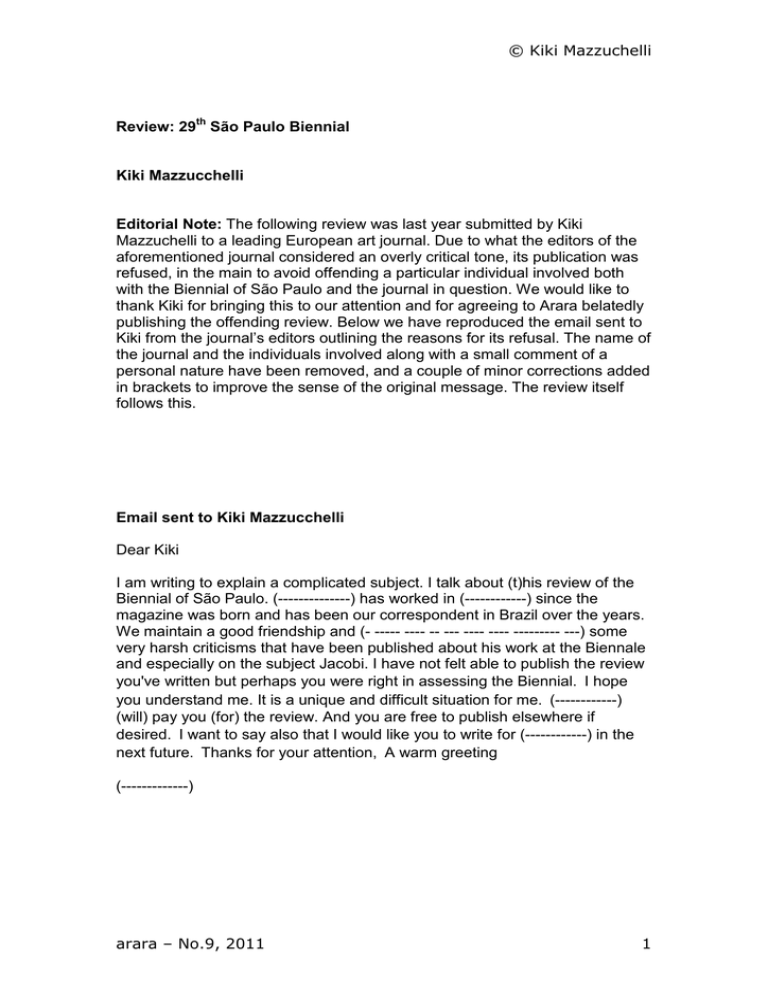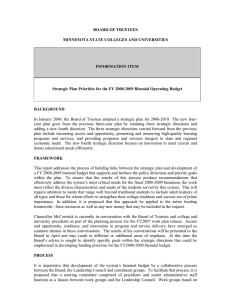Review: 29th São Paulo Biennial
advertisement

© Kiki Mazzuchelli Review: 29th São Paulo Biennial Kiki Mazzucchelli Editorial Note: The following review was last year submitted by Kiki Mazzuchelli to a leading European art journal. Due to what the editors of the aforementioned journal considered an overly critical tone, its publication was refused, in the main to avoid offending a particular individual involved both with the Biennial of São Paulo and the journal in question. We would like to thank Kiki for bringing this to our attention and for agreeing to Arara belatedly publishing the offending review. Below we have reproduced the email sent to Kiki from the journal’s editors outlining the reasons for its refusal. The name of the journal and the individuals involved along with a small comment of a personal nature have been removed, and a couple of minor corrections added in brackets to improve the sense of the original message. The review itself follows this. Email sent to Kiki Mazzucchelli Dear Kiki I am writing to explain a complicated subject. I talk about (t)his review of the Biennial of São Paulo. (--------------) has worked in (------------) since the magazine was born and has been our correspondent in Brazil over the years. We maintain a good friendship and (- ----- ---- -- --- ---- ---- --------- ---) some very harsh criticisms that have been published about his work at the Biennale and especially on the subject Jacobi. I have not felt able to publish the review you've written but perhaps you were right in assessing the Biennial. I hope you understand me. It is a unique and difficult situation for me. (------------) (will) pay you (for) the review. And you are free to publish elsewhere if desired. I want to say also that I would like you to write for (------------) in the next future. Thanks for your attention, A warm greeting (-------------) arara – No.9, 2011 1 © Kiki Mazzuchelli Review: 29th São Paulo Biennial Kiki Mazzucchelli Há sempre um copo de mar para um homem navegar/ There is always a cup of sea to sail in, the title of the 29th São Paulo Biennial, was borrowed from a poem by Jorge de Lima, and it was chosen by chief curators Moacir dos Anjos and Agnaldo Farias because, according to them, it synthesizes the aims of the exhibition, namely, “to affirm that art’s utopian dimension is contained within it, not outside or beyond it”. Drawing on Jacques Rancière’s Politics of Aesthetics, this biennial was presented from the outset as an exhibition which departs from the premise that it is impossible to separate art and politics, affirming the political potential of the aesthetic object in its ability to shortcircuit our perception and to reconfigure “themes and attitudes” that have a real impact on public life. But how to approach the political as the organizing principle for the SPB again, such a short time after the 2006 edition of the event, curated by Lisette Lagnado, which not only presented works that dealt assertively with the theme and gave unprecedented exposure to the artistic production from peripheral countries, but also managed to transform some of the institution’s outdated and worn out structures? For the current exhibition, the curators proposed to assume a critical position in relation to a more “pamphleteering” type of production, and to what they describe as the “extensive movement of approximation between art and politics over recent decades”, which make them blurred “to the point of indistinctness”, seeking to find a balance between the political and the poetic. It is worth remembering that the previous edition of the SPB was marked by the culmination of a state of deep institutional crisis, which led to the appointment of a new president, the executive Heitor Martins, who managed to raise approximately USD 18 million for the current show (a substantial increase from 28th Biennial budget of USD 3.5 million) as well as heading a major reshuffle of council members. Bringing together a team of renowned arara – No.9, 2011 2 © Kiki Mazzuchelli international guest curators formed by Fernando Alvim (Angola), Rina Carvajal (Venezuela/ US), Yuko Hasegawa (Japan), Sarat Maharaj (South Africa/ UK) and Chus Martinez (Spain), and with plenty of financial resources at their disposal, the curators of the 29th São Paulo Biennial had everything in their favour to fulfill the objectives as set out in the presentation text and to put together a thought-provoking exhibition. Everything except, perhaps, enough time: Moacir dos Anjos was only appointed chief curator last July, while the rest of the team came on board only last November. So this time round, as if in a hurried attempt to fill the socalled “void” left by the 2008 event, the Niemeyer pavilion has been overpopulated by works from 159 artists from all over the world. The result is an extremely heterogeneous collection of pieces which are distributed across the three vast floors of the biennial building in a seemingly random fashion, making it difficult to identify precisely which political issues the curators intended to mobilize with this selection of works in an arrangement that resembles individual gallery stands in an art fair. Some of the works shown here, such as those by Brazilian artists from a notably formalist lineage, to give only one example, are very hard to justify in this context, and one wonders whether what is meant by political is the actual inclusion of all kinds of works. There are, of course, some identifiable attempts to create some coherent connections between the works and to articulate these in relation to the exhibition remit. One of the best moments in this biennial is the constellation that brings together five artists that deal, in different ways, with forms of sexuality that are often considered unacceptable, particularly in the over catholic Latin American context. On a long wall we find Colombian artist Miguel Angel Rojas’ beautiful series of black and white photographs Faenza (1979), in which he voyeuristically documented homosexual activities that took place in some cinemas in Bogotá using only the light that emanated from the screen, with the grainy and imprecise quality of the images creating an atmosphere of covertness. Right in front, placed on numerous individual plinths are Efrain Almeida’s small wooden sculptures titled Efrain Almeida, representing the arara – No.9, 2011 3 © Kiki Mazzuchelli naked artist and evoking the traditional catholic statues made in carved wood that are so common across Brazil. Around these, are five delicate wall pieces by José Leonilson – a less known Brazilian artist who died prematurely of AIDS in the early 1990s -, combining drawings, embroidery and highly subjective texts permeated by ambiguity. The axis formed by these three artists is flanked, on one side, by Miguel Rio Branco’s poignant film Nada levarei quando morrer aqueles que mim deve cobrarei no inferno, shot in the historical neighbourhood of Pelourinho (1979-81) in Salvador, Bahia, a subjective and non-linear portrait of its inhabitants in a period when it was the drug dealing and prostitution area. On the other side, Nan Goldin’s Ballad of Sexual Dependency (1979-2004), a work that has been extensively shown worldwide, seems to gain a renewed meaning when placed in relation to so many other works that also deal with ideas of sexuality, religion, family and poverty. Mostly, however, the more interesting pieces shine individually. This is the case of Peruvian artist Sandra Gamarra Heshiki, who in 2002 created the LiMac, a fictional contemporary art museum in the city of Lima whose collection is formed by paintings made by the artist in which she reproduces images of existing artworks that would never integrate a collection in a peripheral country such as Peru. For this biennial, she was commissioned by the curators to produce a series of identical reproductions of Gerard Richter’s October 18,1977 paintings after the Museum of Modern Art in New York refused to lend them to the BSP, as the pavilion in its current state does not comply with their museum standards. Another outstanding piece, which was also commissioned by the Bienal, is Las variables dimensiones del artist, by the Mexican Mario Garcia Torres, in which the artist presents the story of an ex-guerrilla from Venezuela who was involved in the kidnapping of a Cézanne painting the 1960s and her reunion with this work in 2010. Blurring the boundaries between document and fiction, Jonathas de Andrade has updated, following a series of workshops led with students in which they explored the association of images and words, a collection of posters produced according to method developed by influential arara – No.9, 2011 4 © Kiki Mazzuchelli Brazilian educator Paulo Freire to promote adult literacy in the 1970s. In the work of young Latin American artists, the investigation and reactivation of local intellectual and artistic avant-garde production points to what is possibly one of the most intriguing ways of addressing the political today. Unfortunately, in its urge to look for what is termed in the catalogue as “the specificity of art” what this Biennial seems to affirm is that all art is political, making one wonder why this particular theme was chosen on the first place. arara – No.9, 2011 5



